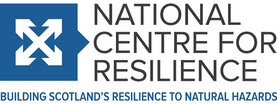Members
 |
British Geological Survey
|
| Outline The British Geological Survey is a world-leading geological survey. It focuses on public-good science for government, and research to understand earth and environmental processes. It is the UK's premier provider of objective and authoritative geoscientific data, information and knowledge to help society to:
The British Geological Survey is a part of the Natural Environment Research Council (NERC) and is its principal supplier of national capability in geoscience. It advances understanding of the structure, properties and processes of the solid Earth system through interdisciplinary surveys, monitoring and research for the benefit of society. It is the UK's premier provider of objective and authoritative geoscientific data, information and knowledge for wealth creation, sustainable use of natural resources, reducing risk and living with the impacts of environmental change. We are a world-leading geoscience centre for:
[detail] --> |
|
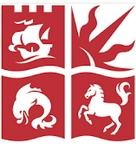 |
Cabot Institute, University of BristolBristol |
| Outline The Cabot Institute, the University of Bristol's first flagship cross-disciplinary research institute, conducts world-leading research on the challenges arising from how we live with, depend on and affect our planet. It is rooted in a recognition of social and environmental challenges but inspired by the spirit of exploration personified by John Cabot (Zuan Caboto) and the City of Bristol. Our main themes focus on the six major issues at the centre of the human-planetary relationship: global environmental change, food, waterand energy security, natural hazards and future cities and communities. Each of these Themes comprises dozens of academics from disciplines spanning the entire university and partners from government, industry, civil organisations and the public. Within each Theme we harness world-leading strength in risk and uncertainty assessment, modelling and big data analysis (underpinned by £4M investment in high performance computing), and expertise in knowledge co-production, security and governance. Crucially, the Cabot Institute brings these Themes - each vibrant in its own right - together. These are strongly interconnected challenges; and interconnected challenges require integrated solutions. The inclusion of a Future Cities theme is a unique feature of the Cabot Institute, arising from our strong partnership with the city of Bristol (European Green Capital 2015) and a recognition that addressing global environmental challenges must be based on a robust understanding of how we live. [detail] --> |
|
 |
|
| Outline Those affected by, or at risk of, disasters and conflict have a right to receive humanitarian aid or disaster risk reduction support in the most timely, effective and appropriate way possible. To achieve this we need to know what works and what doesn't, and to ensure our actions and decisions are based on evidence. Evidence Aid aims to inspire and enable those guiding the humanitarian and DRR sectors to apply an evidence-based approach in their activities and decisions. We will stimulate and satisfy an increasing demand for evidence related to health outcomes, to improve the impact of humanitarian and DRR aid and contribute to a humanitarian and DRR sector where the evidence based approach will be used when and where appropriate. Evidence Aid has successfully engaged in seven systematic reviews for the World Health Organization (details on request), a priority setting exercise (http://currents.plos.org/disasters/article/dis-13-0023-prioritization-of-themes-and-research-questions-for-health-outcomes-in-natural-disasters-humanitarian-crises-or-other-major-healthcare-emergencies/) and a Delphi study (http://www.evidenceaid.org/wp-content/uploads/2013/01/Report-of-Round-1-of-Policy-Delphi-2016-08-22-FINAL1.pdf). In collaboration with Virginia Murray, Evidence Aid successfully co-organised a side event during the UNISDR Science and Technology Conference on the Implementation of the Sendai Framework for Disaster Risk Reduction, addressing issues around evidence dissemination and publication. Afterwards Evidence Aid became a Sendai Framework Science and Technology partner to ensure continuing engagement. For 3ie (International Initiative for Impact Evaluation - http://www.3ieimpact.org/en/), Evidence Aid founder Mike Clarke, contributed to a scoping study to analyse the evidence base of evaluations in humanitarian assistance (http://www.3ieimpact.org/en/publications/3ie-scoping-paper-series/3ie-scoping-paper-1/). All these activities somehow contribute of a more evidence based approach, but not all are convinced this is needed or the best way forward. Evidence Aid will continue to try to convince people that there is a need for more robust evidence and advocate for a more evidence based approach to DRR. [detail] --> |
|
UK-University of Glasgow, National Centre for Resilience
Dumfries |
|
| Outline The University of Glasgow, National Centre for Resilience (NCR) is an academic research hub, using evidence to inform policy and practice. It bridges the gap between academia, policy and practice by promoting cross sector partnerships, encouraging each to learn from the other to improve resilience when planning for, responding to and recovering from natural hazard events in Scotland. The NCR utilises existing knowledge, commissions demand led research projects and funds practical projects to address real life issues faced by resilience practitioners and communities. Using its networks, it creates links for researchers to help them adapt their project outputs into tailored briefings and tools for end users and then maximises the potential use and impacts of this work by disseminating research outputs. [detail] --> |
|
 |
Global Disaster Resilience Centre (GDRC)
|
| Outline What would it be like to live in a world in which government authorities, businesses, communities and individuals work together to create a society that is able to withstand the effects of unforeseen events and threats? At the Global Disaster Resilience Centre we are working with stakeholders at the global, national and local level to make this happen. The Global Disaster Resilience Centre is committed to excellence in research, education and advocacy to improve the resilience of nations and communities to disasters. With growing population and infrastructures, the world's exposure to hazards is increasing. When disaster strikes, communities may need to be rebuilt physically economically and socially. At the same time, it is vital that any reconstruction activity pro-actively considers how to protect people and their environment, and reduce a community's vulnerability. The Global Disaster Resilience Centre is part of the School of Art, Design and Architecture at the University of Huddersfield in the UK. In November 2013, the University of Huddersfield was awarded the Times Higher Education University of the Year. The University excels in enterprise and innovation and in 2012, was named the Times Higher Education Entrepreneurial University of the Year. We:
[detail] --> |
|
UK - Leicester
School of Business, Dept. Management, Innovation and Technology Division, University of LeicesterLeicester |
|
| Outline The University of Leicester School of Business is a global academy for leaders, innovators and change-makers. Building on over 90 years of delivering business education, we are internationally renowned for our courses in accounting and finance, management, marketing and economics. Reflecting the pioneering work we conduct in partnership with leaders, managers and organisations to promote responsible business practice, we are ranked 14th in the UK for research power. |
|
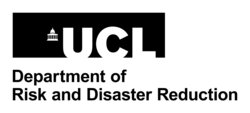 |
UCL Department of Risk and Disaster Reduction (RDR)
|
| Outline The UCL Department of Risk and Disaster Reduction (RDR) inspires innovation and evidence-based practice focused on improving disaster risk reduction (DRR) through our research, education, and partnerships. This creates a better life for many people by reducing the negative impacts of disasters. The RDR is an exciting cross-UCL department leading research, knowledge, education and humanitarian action. By providing a focus for UCL activities in risk, disaster and humanitarianism, with its breadth of disciplinary emphasis, promotion of novel multidisciplinary research and translation into practice, the RDR aims to assume a role of leadership both in the UK and internationally. The department is in the Faculty of Mathematics and Physical Sciences (MAPS), but works across all UCL's faculties, spanning natural and social sciences, mathematics and statistics, engineering and development planning, global health, anthropology, the humanities, ethics and laws, and contributes to UCL's Grand Challenges. UCL is consistently ranked as one of the top ten universities in the world (QS World University Rankings 2010-2025) and is No.2 in the UK for research power (Research Excellence Framework 2021). Furthermore, UCL is 1st pace in the UK, 2nd in Europe and 3rd globally in the QS World Sustainability Rankings 2026 and has held First Class status in the People and Planet University League for seven consecutive years." [detail] --> |
|
UK - WEDC, Loughborough University
 |
Water Engineering and Development Centre (WEDC)Loughborough University
|
| Outline The Water Engineering and Development Centre (WEDC) is a globally leading research group that undertakes high-calibre and creative multidisciplinary research and provides high quality, research-led education and training for the next generation of professionals and leaders to tackle global challenges in the broad field of water engineering and development. Founded more than 50 years ago to address the issues of providing safe water and sanitation in low- and middle-income countries, WEDC has grown to face the common challenges of water engineering in both developed and developing countries, including water quality and security, water hazards and risk resilience, hydrodynamics, fluvial processes and catchment management. [detail] --> |
|
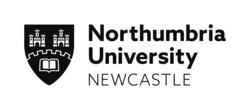 |
Disaster and Development Network (DDN)
|
| Outline The Disaster and Development Network (DDN) aims to develop through research, teaching and learning, the knowledge and skills to address hazards, disasters and complex emergencies from the perspective of different development debates and experience. The Network undertakes research, teaching and learning activities that encompass disaster reduction, sustainable development and resilience building. By necessity an inter-disciplinary field of inquiry, disaster and development studies address human security and wellbeing for individuals, groups and institutions in contexts of current and potential crises. [detail] --> |
|
 |
Overseas Development Institute
|
| Outline The Overseas Development Institute (ODI) is a leading independent think tank on international development and humanitarian issues. Our mission is to inspire and inform policy and practice which lead to the reduction of poverty, the alleviation of suffering and the achievement of sustainable livelihoods in developing countries.
[detail] --> |
|
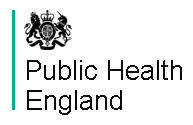 |
Public Health England
|
| Outline We are an executive agency of the UK Department of Health, and a distinct delivery organisation with operational autonomy to advise and support the government, local authorities and the NHS in a professionally independent manner. We employ 5,500 staff (full-time equivalent), mostly scientists, researchers and public health professionals. We have 8 local centres, plus an integrated region and centre for London, and 4 regions (north of England, south of England, Midlands and east of England, and London). We work closely with public health professionals in Wales, Scotland and Northern Ireland, and internationally. Public Health England was established on 1 April 2013 to bring together public health specialists from more than 70 organisations into a single public health service. PHE's research within disaster risk reduction aims to ensure public health and science has a prominent role in the Sendai framework. To achieve this, PHE regularly conducts robust, evidence-based research into disaster risk reduction. PHE is an executive agency, sponsored by the Department of Health. [detail] --> |
|
 |
Swansea University
|
| Outline Swansea University is a research-led university that has been making a difference since 1920. The University community thrives on exploration and discovery, and offers the right balance of excellent teaching and research, matched by an enviable quality of life. The University has enjoyed a period of tremendous growth, and we have achieved our ambition to be a top thirty research University, soaring up the 2014 Research Excellence Framework league table to 26th in the UK from 52nd in 2008. Additionally, an ambitious Campus Development Programme is well underway - one of the largest knowledge economy projects in the UK and within the top five in Europe. It involves the creation of the Bay Campus, a brand new £450 million development on the eastern approach to the city, together with the transformation of our existing Singleton Park Campus. Swansea's multicultural dual-campus community provides a global perspective and opportunities to gain skills that last a lifetime. True to the vision of its industrial founders in 1920 Swansea University will: Provide an environment of research excellence, with research that is world-leading, globally collaborative and internationally recognised; Deliver an outstanding student experience, with research-led and practice-driven teaching of the highest quality that produces global graduates educated and equipped for distinguished personal and professional achievement; Use its research strength, collaboration with industry and global reach, to drive economic growth, foster prosperity, enrich the community and cultural life of Wales and, contribute to the health, leisure and wellbeing of its citizens. You can also read more about the University's history, ambitions, and management. [detail] --> |
|
UK - University of Salford
 |
Centre for Disaster Resilience, University of Salford
|
| Outline Our aim is to be a global leader in built environment research and education that develops societal resilience to disasters. Within this holistic societal goal lies a more specific community objective of building resilience and adaptation measures. In achieving this aim the centre's strategy is to focus on the strengths of the existing multidisciplinary membership, our portfolio of funded research projects, our existing postgraduate research community and our national and international collaborative partners. RESEARCH TOPICS
CDR has led and contributed to a wide range of projects within the broad theme of disaster resilience:
[detail] --> |
|
USA - The University of Alabama
The University of Alabama, Center for Sustainable InfrastructureAlabama |
|
| Outline The mission of the Center for Sustainable Infrastructure (CSI) is to conduct research associated with constructing, expanding, maintaining, and rehabilitating all aspects of physical infrastructure. The Center facilitates and leads multi-disciplinary, collaborative programs and explores linkages between different infrastructure systems that are traditionally studied in separate specialty areas. The Center is particularly focused on the safe and efficient creation of resilient infrastructure, including assessment of infrastructure condition, vulnerability, and recovery from disaster. Four key research themes of the CSI are 1) multi-hazards community-based resilience, 2) energy simulation and retrofitting of buildings, 3) accelerated and automated construction, and 4) advanced materials for civil infrastructure. Its Large Scale Structures Laboratory (LSSL) contains a 75-foot by 40-foot test floor with a 3-foot thick strong floor, two 15-ton capacity overhead cranes, and 2-foot thick reconfigurable reinforced-concrete blocks that can be stacked and post-tensioned to the strong floor to provide reaction walls on the testing floor. The sponsors of research projects include National Science Foundation, Federal Highway Administration, National Institute of Standards and Technology, Department of Defense, Department of Energy, State DOTs, and the industry. [detail] --> |
|
USA - Arizona State University
 |
Center for Emergency Management and Homeland Security (CEMHS)Arizona State University (ASU)Arizona |
| Outline We want to transform the emergency management and homeland security landscape through transdisciplinary discovery and practice, in which knowledge, risk reduction, community development and sustainability operate collaboratively to reduce risks and vulnerabilities and adapt communities to new "normals." By connecting practitioners, students and the wider ASU academic community and its resources, CEMHS is co-developing research and knowledge. |
|
 |
Pacific Earthquake Engineering Research Center (PEER)
|
| Outline The Pacific Earthquake Engineering Research Center (PEER) is a multi-institutional research and education center with headquarters at the University of California, Berkeley. Investigators from over 20 universities, several consulting companies, plus researchers at various State and Federal government agencies contribute to research programs focused on performance-based earthquake engineering in disciplines including structural and geotechnical engineering, geology/seismology, lifelines, transportation, risk management, and public policy. The PEER mission is to develop, validate, and disseminate performance-based seismic design technologies for buildings and infrastructure to meet the diverse economic and safety needs of owners and society. PEER's research defines appropriate performance targets, and develops engineering tools and criteria that can be used by practicing professionals to achieve those targets, such as safety, cost, and post-earthquake functionality. In addition to conducting research to develop performance-based earthquake engineering technology, PEER actively disseminates its findings to earthquake professionals who are involved in the practice of earthquake engineering, through various mechanisms including workshops, conferences and the PEER Report Series. PEER also conductsEducation and Outreach programs to reach students, policy makers, and others interested in earthquake issues. PEER was established as a consortium of nine West Coast Universities in 1996 and gained status as a National Science Foundation Engineering Research Center in 1997. PEER graduated from NSF Funding in 2008 and is now supported by federal, state, local and regional agencies together with industry partners. Despite this funding shift, PEER continues to grow and remains an active earthquake engineering research center with a wide spectrum of technical activities and projects. PEER now has ten Core Institutions but also actively involves researchers, educators, students, and earthquake professionals from across the US and worldwide. [detail] --> |
|
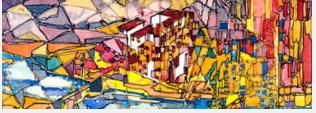 |
Resilient Communities Research Institute (RCRI)
|
| Outline The Resilient Communities Research Institute (RCRI) in the College of Architecture and Environmental Design (CAED) is an applied research unit devoted to advancing the application of knowledge and practice that improves the quality and safety of the built environment. The RCRI is a catalyst for creating effective and productive applied research partnerships. The RCRI is where answers to real world questions are formulated, where partnerships with the civil society yield community benefits, and where the next generation of student leaders become involved in research and solutions based design. The RCRI assembles faculty, supervised students and professional affiliates to work on projects of faculty interest and community and professional need. The RCRI engages in grant/contract supported applied research, fee supported projects, and community service programs. These programs and projects are focused on the built and ecological environments and the factors that shape them. It sponsors educational workshops and provides a variety of reports and presentations that further the activities on behalf of RCRI members and partners. While the quality and safety of California's built environment is the primary RCRI focus, broader issues of global importance will also be addressed. We live in a complex and constantly adjusting world. Solutions require collective work and the RCRI uses the collective expertise approach and innovative technology, to answer the questions of how create, maintain and enhance a sustainable built environment. [detail] --> |
|
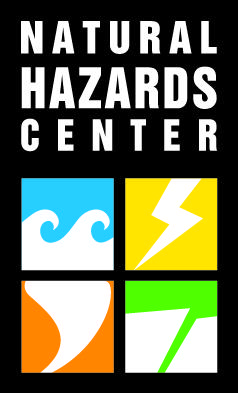 |
Natural Hazards Center
|
| Outline Since 1976, the Natural Hazards Center has served as a national and international clearinghouse of knowledge concerning the social science and policy aspects of disasters. The Center collects and shares research and experience related to preparedness for, response to, recovery from, and mitigation of disasters, emphasizing the link between hazards mitigation and sustainability to both producers and users of research and knowledge on extreme events. A basic goal of the Center is to strengthen communication among researchers and the individuals, organizations, and agencies concerned with reducing damages caused by disasters. More than a quarter century of cultivating discourse among these groups has placed the Natural Hazards Center center-stage in both the national and global hazards communities. Ongoing support for Center activities is primarily provided by the National Science Foundation and other agencies that support the Center's mission. Recent funding partners include the U. S. Army Corps of Engineers, the U. S. Geological Survey, the National Institute of Standards and Technology, the National Oceanic and Atmospheric Administration, and the Federal Emergency Management Agency. Swiss Re has also provided additional funding. The Center is guided by a National Advisory Committee comprised of representatives of federal agencies that have an interest in hazards as well as stakeholders from academia, state and local government, the private sector, and nongovernmental organizations. The Center has always promoted an all-hazards approach for dealing with environmental extremes and has been a leading proponent of cooperative partnerships among varying disciplines. [detail] --> |
|
 |
Center for Risk-Based Community Resilience Planning
|
| Outline The ability to model community resilience comprehensively requires that experts from a number of disciplines work in concert to systematically model how physical, economic and social infrastructure systems within a real community interact and affect recovery efforts. There are currently no models that consider all aspects of how a natural hazard affects a community or that measure its resilience quantitatively. The Center for Risk-Based Community Resilience Planning is unique in merging the disciplines of Engineering, Social Sciences and Economics to model community resilience comprehensively. Systems that are essential for the recovery and vitality of a community - technological, financial, social and political support, healthcare delivery, education, and public administration - are being integrated in the model, creating a nexus between social and technological infrastructure that will narrow the gap between engineering and social science aspects of resilience planning and will facilitate risk communication among stakeholders and community resilience planners. The work products from the Center will provide a science-based approach to community resilience assessment and, for the first time, will support a business case for enhancing resilience at the community level. Full validation of the system architecture in IN-CORE will be possible through extensive field studies focused on community resilience and recovery rather than simply infrastructure damage and failure studies. IN-CORE will be able to answer detailed questions on the lingering effects of natural hazards on communities; population dislocation, health and the well being of the residents, impacts across the economic spectrum as well as the fiscal impacts, thereby assessing community resilience and recovery via a suite of resilience metrics. [detail] --> |
|
 |
Disaster Research Center (DRC)
|
| Outline The Disaster Research Center is committed to advancing the state of the art and the scientifically guided practice in disaster research; educating the next generation of disaster science scholars and informed practitioners in the fields of disaster mitigation, preparedness, response and recovery; and creating, gathering, and disseminating disaster knowledge in a dynamic and responsive way. Vision of DRCTo be the leader in advancing disaster knowledge, through multi-disciplinary research, that contributes to solving complex social problems related to disasters. HistoryThe Disaster Research Center was established in 1963 and now, fifty years later, DRC is celebrating its continued success in research, training and service to the disaster community. DRC was established at The Ohio State University in 1963 by Professors E.L. Quarantelli, Russell Dynes and J. Eugene Haas and moved to its current location at the University of Delaware in 1985. The Center was the first in the world devoted to the social scientific study of disasters. Research Achievements and Challenges:DRC is proud of the diverse demographic profile amongst its students, including those hailing from Asia, the Caribbean, Europe, South America, Southwest Asia, and the Middle East. Most recently the Center became quite active with the William A. Anderson Fund, a service organization named for gifted researcher and revered DRC alum William A. (Bill) Anderson. Bill had a distinguished career in academia, the World Bank, and the National Science Foundation in advancing disaster research, especially interdisciplinary research. The goal of the Fund is to increase the number of historically underrepresented students in disaster science and practice. DRC faculty are actively involved in student mentoring, holding professional development workshops, and other activities in support of the Fund. The Center is excited that the William A. Anderson Fund has joined DRC, with the University of Delaware as the Flagship institution for the Fund's activities, which will also include a number of satellite universities around the country. [detail] --> |
|

